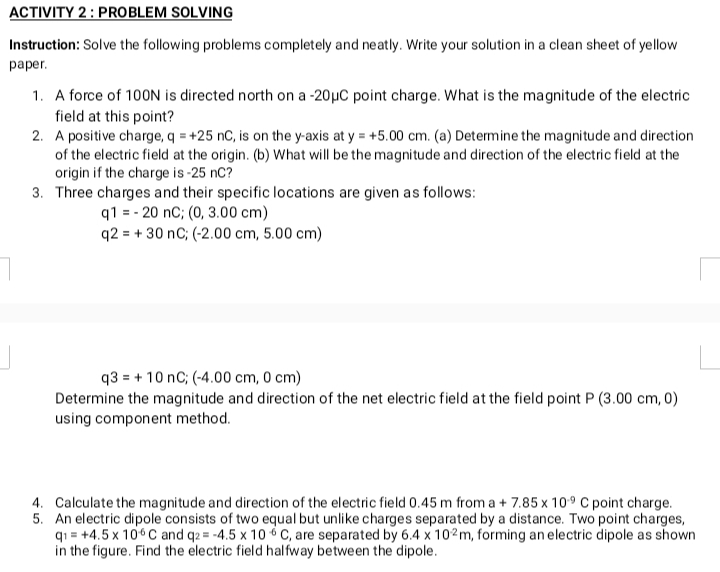Physics for Scientists and Engineers: Foundations and Connections
1st Edition
ISBN:9781133939146
Author:Katz, Debora M.
Publisher:Katz, Debora M.
Chapter24: Electric Fields
Section: Chapter Questions
Problem 28PQ: The electric field at a point on the perpendicular bisector of a charged rod was calculated as the...
Related questions
Question

Transcribed Image Text:ACTIVITY 2: PROBLEM SOLVING
Instruction: Solve the following problems completely and neatly. Write your solution in a clean sheet of yellow
paper.
1. A force of 100N is directed north on a -20µC point charge. What is the magnitude of the electric
field at this point?
2. A positive charge, q = +25 nC, is on the y-axis at y = +5.00 cm. (a) Determine the magnitude and direction
of the electric field at the origin. (b) What will be the magnitude and direction of the electric field at the
origin if the charge is -25 nC?
3. Three charges and their specific locations are given as follows:
q1 = - 20 nC; (0, 3.00 cm)
q2 = + 30 nC; (-2.00 cm, 5.00 cm)
q3 = + 10 nC; (-4.00 cm, 0 cm)
Determine the magnitude and direction of the net electric field at the field point P (3.00 cm, 0)
using component method.
4. Calculate the magnitude and direction of the electric field 0.45 m from a + 7.85 x 109 C point charge.
5. An electric dipole consists of two equal but unlike charges separated by a distance. Two point charges,
q1 = +4.5 x 106C and q2 = -4.5 x 10 6 C, are separated by 6.4 x 102m, forming an electric dipole as shown
in the figure. Find the electric field halfway between the dipole.
Expert Solution
This question has been solved!
Explore an expertly crafted, step-by-step solution for a thorough understanding of key concepts.
Step by step
Solved in 2 steps with 1 images

Knowledge Booster
Learn more about
Need a deep-dive on the concept behind this application? Look no further. Learn more about this topic, physics and related others by exploring similar questions and additional content below.Recommended textbooks for you

Physics for Scientists and Engineers: Foundations…
Physics
ISBN:
9781133939146
Author:
Katz, Debora M.
Publisher:
Cengage Learning

Principles of Physics: A Calculus-Based Text
Physics
ISBN:
9781133104261
Author:
Raymond A. Serway, John W. Jewett
Publisher:
Cengage Learning

College Physics
Physics
ISBN:
9781285737027
Author:
Raymond A. Serway, Chris Vuille
Publisher:
Cengage Learning

Physics for Scientists and Engineers: Foundations…
Physics
ISBN:
9781133939146
Author:
Katz, Debora M.
Publisher:
Cengage Learning

Principles of Physics: A Calculus-Based Text
Physics
ISBN:
9781133104261
Author:
Raymond A. Serway, John W. Jewett
Publisher:
Cengage Learning

College Physics
Physics
ISBN:
9781285737027
Author:
Raymond A. Serway, Chris Vuille
Publisher:
Cengage Learning


College Physics
Physics
ISBN:
9781305952300
Author:
Raymond A. Serway, Chris Vuille
Publisher:
Cengage Learning